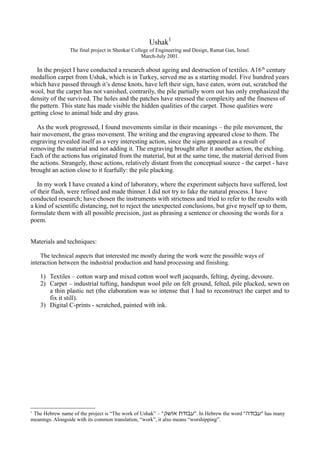Ushak
- 1. Ushak1 The final project in Shenkar College of Engineering and Design, Ramat Gan, Israel. March-July 2001. In the project I have conducted a research about ageing and destruction of textiles. A16 th century medallion carpet from Ushak, which is in Turkey, served me as a starting model. Five hundred years which have passed through itŌĆÖs dense knots, have left their sign, have eaten, worn out, scratched the wool, but the carpet has not vanished, contrarily, the pile partially worn out has only emphasized the density of the survived. The holes and the patches have stressed the complexity and the fineness of the pattern. This state has made visible the hidden qualities of the carpet. Those qualities were getting close to animal hide and dry grass. As the work progressed, I found movements similar in their meanings ŌĆō the pile movement, the hair movement, the grass movement. The writing and the engraving appeared close to them. The engraving revealed itself as a very interesting action, since the signs appeared as a result of removing the material and not adding it. The engraving brought after it another action, the etching. Each of the actions has originated from the material, but at the same time, the material derived from the actions. Strangely, those actions, relatively distant from the conceptual source - the carpet - have brought an action close to it fearfully: the pile plucking. In my work I have created a kind of laboratory, where the experiment subjects have suffered, lost of their flash, were refined and made thinner. I did not try to fake the natural process. I have conducted research; have chosen the instruments with strictness and tried to refer to the results with a kind of scientific distancing, not to reject the unexpected conclusions, but give myself up to them, formulate them with all possible precision, just as phrasing a sentence or choosing the words for a poem. Materials and techniques: The technical aspects that interested me mostly during the work were the possible ways of interaction between the industrial production and hand processing and finishing. 1) Textiles ŌĆō cotton warp and mixed cotton wool weft jacquards, felting, dyeing, devoure. 2) Carpet ŌĆō industrial tufting, handspun wool pile on felt ground, felted, pile plucked, sewn on a thin plastic net (the elaboration was so intense that I had to reconstruct the carpet and to fix it still). 3) Digital C-prints - scratched, painted with ink. 1 The Hebrew name of the project is ŌĆ£The work of UshakŌĆØ ŌĆō "ŌĆ½ ."ūóūæūĢūōū¬ ūÉūĢū®ū¦ŌĆ¼In Hebrew the word "ŌĆ½ "ūóūæūĢūōūöŌĆ¼has many meanings. Alongside with its common translation, ŌĆ£workŌĆØ, it also means ŌĆ£worshippingŌĆØ.

